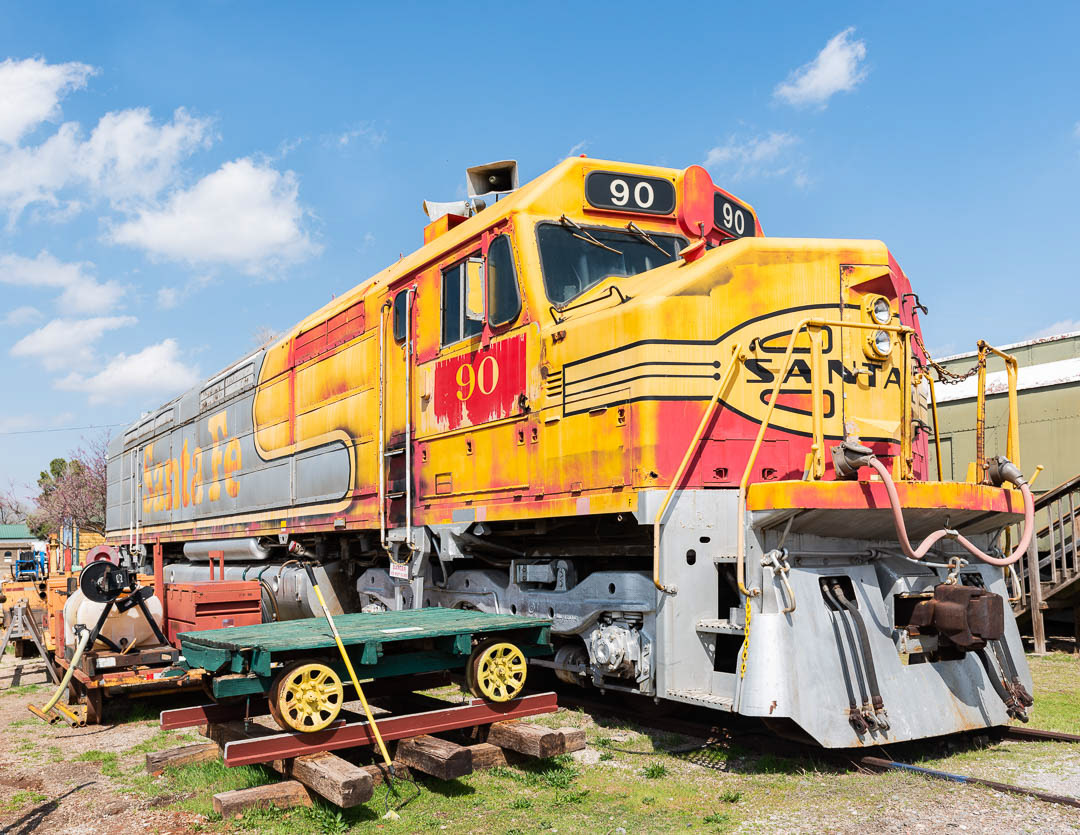















I will be referencing the following photographs from left to right. Blackwell Engine #1096 The first photograph is of Engine No. 1096, with a prairie wheel layout of 2-6-2 (two front pilot wheels, six driving wheels, and two rear wheels), which was built in 1902 by Baldwin Locomotive Works. Its more than 50 year service life ended, after an estimated more than 1,259,000 miles to its credit, with its last run in 1953 to Wellington, Kansas. This engine is on public display in Blackwell, Oklahoma, where a young girl told me while I was photographing it that she really liked this engine because there were so many places to hide. Santa Fe Locomotive Engine No. 2542 The second photograph shows Santa Fe Locomotive Engine No. 2542, which was built by the American Locomotive Company in Pittsburgh, Pennsylvania in 1910 for the KCM&O railroad. It was purchased by the AT&SF in 1929 and placed in Newton, Kansas. It is a 2-8-0 engine: two front wheels, eight drive wheels, and no rear wheels. Upon its retirement in 1955, it was moved to Wilson Park in Arkansas City, Kansas and dedicated as part of the twenty-fourth annual town celebration. It deteriorated considerably over the next 65 years and was extensively restored and rededicated in 2017. When I took this photograph in 2023, children were gleefully playing on it just as my children did 40 years ago. Big Boy No. 4014 The next three photographs are of Big Boy No. 4014, which is the only remaining operational Big Boy of the original 25 built by the American Locomotive Company exclusively for the Union Pacific Railroad beginning in 1941. The company describes it as: “132 feet long and weighed 1.2 million pounds. Because of their great length, the frames of the Big Boys were ‘hinged,’ or articulated, to allow them to negotiate curves. They had a 4-8-8-4 wheel arrangement, which meant they had four wheels on the leading set of ‘pilot’ wheels which guided the engine, eight drivers, another set of eight drivers, and four wheels following which supported the rear of the locomotive. The massive engines normally operated between Ogden, Utah, and Cheyenne, Wyo.” This engine “was retired in December 1961, having traveled 1,031,205 miles in its 20 years in service.” After completion of its restoration, it “returned to service in May 2019 to celebrate the 150th Anniversary of the Transcontinental Railroad's Completion.” Since then it has been in excursion service. I took these photographs of it on November 16, 2019, as it arrived in Coffeyville, Kansas, while on an extensive tour. Diesel Engines I remember enjoying riding on steam powered trains between locations that are only served by buses now. Time and technology have marched on. Diesel engines proved more cost efficient. And so we entered a new age, but the romance of the steam powered locomotive lives on. The next four photographs after Big Boy were taken at the Oklahoma City Railway Museum, which has a treasure trove of trains, both steam and diesel, and related artifacts. They are followed by Union Pacific engines waiting for a wheel change and then a row of wheels on axles awaiting trains in Oakley, Kansas. Next is a BNSF train approaching the Harper, Kansas train station, which now serves as a BNSF maintenance building. The next photograph shows railroad cars lined up at a grain elevator in Blackwell, Oklahoma. The last three photographs are taken in Ponca City, Oklahoma.















